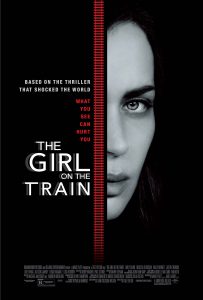‘The Girl on the Train’ a Digressive, Dizzying Ride
Like the novel upon which it is based, The Girl on the Train takes a few detours, but when it’s moving forward, which is often enough, it thrills.
Most of the detours are into backstory, and there is a lot of it, juggled by three main characters. However, the movie renders the backstory clearly and concisely. Whenever director Tate Taylor shifts the narrative perspective from one character to another, the name of the new narrator appears on the screen before the cinematography continues. Think chapter titles. It’s an effective framing device, one borrowed from the book.

Emily Blunt at the 2012 Toronto International Film Festival. photo: gdcgraphics and Wikipedia.
The movie opens in the perspective of Rachel (Emily Blunt). Her husband, Tom Watson (Justin Theroux), left her for another woman, Anna (Rebecca Ferguson). Every day, Rachel commutes by train from the suburbs to Manhattan past her old home, where Tom lives with his new family. To distract herself, she fantasizes about the presumably happy couple living two doors down: Megan (Haley Bennett) and Scott Hipwell (Luke Evans).
Rachel is unemployed, though her roommate, Cathy (Laura Prepon), doesn’t know it. Both in New York and on the train, Rachel spends her time sketching in a notebook. During one commute, a mother and baby sit beside her. Their presence cheers her up until the mother notices the vodka bottle in Rachel’s purse. Both women turn away from each other, embarrassed.
The narrative then shifts not only to Megan but also to six months earlier. She sits in the office of her therapist, Dr. Kamal Abdic (Édgar Ramírez). Her husband wants children; she doesn’t. She nannies, but when she finishes work, she goes straight to the shower to wash the baby’s smell off her. We also learn her brother died young, and after his death, she ran away from home with his best friend. The couple lived in an isolated cabin for a year before breaking up.
Megan nannies for Tom and Anna’s baby, something which we learn in Anna’s perspective. As the women fold a bedspread, Megan tells Anna that she is quitting, effective today. Anna protests, but Megan is adamant. She has gotten a job in an art gallery, a real job, something important.
“There’s no job more important than raising a child,” Anna says.
The female characters will spend the duration of the film either upholding or undermining this belief. For instance, we soon learn Rachel’s alcoholism began because of her inability to conceive a child with Tom. (Her alcoholism, in turn, is what allegedly drove Tom toward Anna.) The impetus of the plot follows a well-worn path.
Similarly, the men don’t do much to challenge gender stereotypes. Both Tom Watson and Scott Hipwell are hulks of testosterone, who copulate, yell, and do little else. Each, to different degrees, is suspicious of their respective spouses. The exception is Abdic, whom Ramírez plays with calm empathy. Infidelity appears to run rampant among both sexes save Rachel.

While riding the train one Friday morning, Rachel observes Megan kissing a man—not Scott. The sight rekindles the rage that she felt when she learned of Tom’s affair. She spends the day fueling that rage with booze, culminating in the film’s strongest scene.
At a bar, she befriends another female patron. The pair go to the restroom, where Rachel writes in lipstick on the mirror a series of Xs. These Xs hark back to the “kisses” in the subject line of an email between Tom and Anna. Rachel then wraps her arm around her new friend, holds out her phone, presses record, and they yell, “Fuck you, Tom.” The moment is captured on three mediums: the phone’s screen, the restroom mirrors, and, of course, the movie camera. Three angles. None of them flattering. Rachel is fracturing apart.
Rachel’s literary counterpart is overweight, but the casting directors went with Blunt, who is not. Still, Blunt manages to distance herself from Hollywood’s high standards toward what a heartbroken alcoholic would likely look like. In this scene, and indeed throughout the movie, her face is puffy and red with drink, hair clumpy, mascara smeared.
Rachel takes the train back to the suburbs. She spies Megan jogging, follows her into a tunnel, calls her a whore, and then everything goes black. The next morning, Rachel is bloody, bruised, and hungover, but with no memory of last night. Worse, Megan Hipwell is missing. Both Rachel and the audience must confront the very real possibility that Rachel killed her.
Solving the mystery empowers Rachel, giving her purpose. She visits Abdic and Scott Hipwell, oftentimes further muddling what is already a fuzzy memory. She’s reckless, and a viewer may wonder why the detectives are aloof. One of the few changes in the transition from book to movie is the marginalization of the detectives. A necessary cut to keep the runtime trim, though it’s at the expense of Detective Sgt. Riley (Allison Janney) especially. She is one of the movie’s stronger female characters.
Another difference between the book and the screenplay, the latter written by Erin Cressida Wilson, concerns setting. The novel takes place in and around London; the film, in and around New York. Although fans of the book may have strong opinions about the switch, as I did, it does not affect the plot.
As Rachel sneaks around her former street, she must avoid Tom and Anna, whom she has allegedly harassed over the past year. All this avoiding, plus the reveal that Rachel (sort of, briefly) kidnapped Tom and Anna’s baby, keeps the tension high.
Meanwhile, the narrative continues to flash back to Megan, her perspective moving forward in time from six months ago to that night in the tunnel. Along the way, we learn just what happened in that cabin so many years earlier, another bombshell. An unsettling score by Danny Elfman helps to bring to a head the night of Megan’s disappearance and the film’s conclusion. It’s a series of scenes that will leave audiences on both sides of the pond, and indeed around the world, with chills and anxiety from all the suspense.
Christopher Maggio is a Pittsburgh-based writer and editor and loves going to the movies.
Share on Social Media
Follow Entertainment Central
Latest Stories
Sign up for the EC Newsletter







